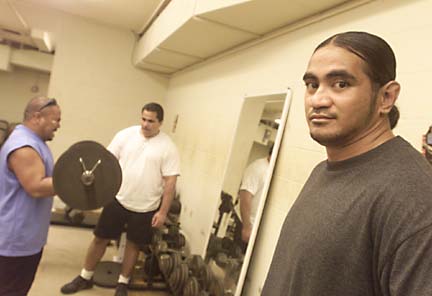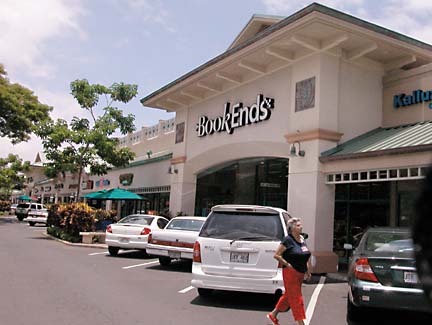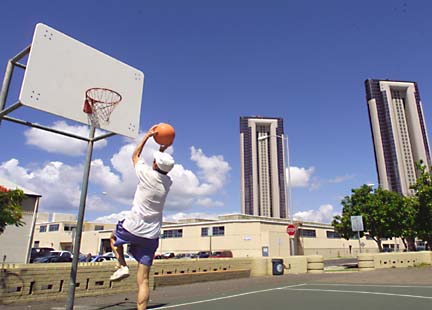
Kakaako's transformation from industrial zone to urban hot spot seems to have come at lightning speed, but its shifting profile has been the talk for decades. Accelerated by Victoria Ward's initiative and by the University of Hawaii's plans for a medical center, the district formerly marked by car repair shops and an ironworks foundry now gleams with pricey condominiums and the ubiquity of national retail chains.
Across the island, the ever-present Starbucks and Dunkin Donuts have crept into Kailua, too, although it still holds onto its "Leave It to Beaver" 1950s atmosphere through an active and involved community who like their beach town just like it is.
Palolo, too, is changing. The place that was described as the "wild, wild West" is now helping wayward teens find a better way, thanks in part to the work at Palolo District Park.
Palolo | Kailua | Kakaako
BACK TO TOP |
FL MORRIS / FMORRIS@STARBULLETIN.COM
Loa Faimealelei runs the weight room at Palolo District Park gym. In back, Keoni Bermudez, left, and Kenny Noa lift. The facility also has a computer center.
Relieving boredom
brought changes to
former ‘war zone’
Loa Faimealelei's story serves to represent Palolo's transition from the bad old days of gangs and danger to the hopeful days of the present.
Faimealelei, now a 30-something adviser to teens at Palolo District Park, was up to no good in his own teen years. While not a true gang member, "I hung out with all the guys," by which he doesn't mean nice guys.
They were troublemakers, stealing cars, "the whole nine yards," Faimealelei says. "There was nothing else to do."
Boredom. It's what Faimealelei and his mentor, parks and recreation director Joe Yasutake, blame for the condition of the area more than a decade ago, "when this place was a war zone," as Yasutake describes it.
"Now," he says, "it's like any peaceful place."
Yasutake signed on at the park in 1990 and began introducing youth programs, including all-important sports. Basketball and baseball leagues drew him and his friends off the streets, Faimealelei says. "When Joe came, everything changed. He put all the programs together, hustled, got all the coaches. All the kids started staying, 'We got something to do now.'"
Faimealelei became a volunteer and, with help from his church, got his life together. Now he's a recreation aide, mainly responsible for maintaining the weight room. "Now I'm a city worker," he says.
FL MORRIS / FMORRIS@STARBULLETIN.COM
Summer Stephens works at a computer at the Palolo District Park's Mutual Assistance Association Center.
Yes, Palolo District Park has a weight room, as well as a computer center; it offers a basketball tournament as well as literacy programs.
Yasutake hopes to open a video center soon, funded by earnings at the annual Palolo Pride celebration, another project that began at the park.
To make all this happen, Yasutake depends on a network of volunteers and donors. "I beg and borrow but I don't steal."
His stock in trade is favors -- he does them for others and expects them returned. "I learned that from watching 'The Godfather.' ... You owe me money, you can pay me back, but favors -- I'm going to collect on your behind until the day you die."
While no one would claim all of Palolo's problems have been solved, there have been improvements. Once, Palolo kids filled special-education programs; that's changed, Yasutake says. Now he's writing recommendations for Palolo high school students headed for college.
"This place was a wild, wild West," he says. The solution was not to chase the gangs away, but to invite them in. "Our programs became their turf."
Like Faimealelei, many are now grown up in every way, and helping with the youth programs. That's not, unfortunately, a universal truth.
Rodney Laulusa, killed in a confrontation with police in 1998 at Palolo Valley Housing, was one of Faimealelei's close friends.
"Some of them had a harder time," he says, "but for most of us, it turned out pretty good."
BACK TO TOP |
CRAIG T. KOJIMA / CKOJIMA@STARBULLETIN.COM
The tree-lined medial strip that divides Kailua Road has helped to calm traffic and beautify the area.
The town and its beach
are adored by residents
Its beach was once ranked the best in the nation.
The annual Fourth of July fireworks event, formerly in danger of fizzling out, now attracts thousands from around the island.
And the downtown area has been spruced up in recent years to give it a more inviting feel.
No wonder the town throws a party for itself every April and simply calls it "I Love Kailua."
This self-contained Windward community, home to 52,000 residents, is like the pot of gold at the end of the rainbow. It's where you end up when you reach the bottom of Pali Highway coming from Honolulu.
What you see as you drive into town are clusters of small shops anchored by well-known supermarkets and retailers -- Safeway, Foodland, Times and Daiei, as well as Macy's, Longs Drug Store and Starbucks.
About a mile east is one of the town's most popular attractions, Kailua Beach. Its sandy-bottomed ocean and calm waves are popular with families, while the windy yet gentle conditions provide a great venue for windsurfing, kite surfing and kayaking. The beach park offers restroom facilities, showers, a concession stand, picnic tables and a bicycle/jogging path.
"I've met people on the mainland who say that when they visit Hawaii, the place they really love is Kailua and Lanikai, mainly because of the beaches," said Kailua auto dealer Mike McKenna. "It's really a sense of pride with people in the community."
CRAIG T. KOJIMA / CKOJIMA@STARBULLETIN.COM
The recently remodeled Kailua Shopping Center -- across the street from Macy's -- is also home to Times Super Market.
McKenna, whose Ford, Volkswagen/Mazda and other auto-related lots occupy more than five acres downtown, said he's seen a lot of changes since planting roots in Kailua in 1990.
"The biggest change is just the complexion of the downtown area," he said. "When we came here in 1990, the downtown area was run down. ... Now the buildings are all spruced up. I've never seen a city that's changed this much in 13 years."
The community is spread out, too. Besides the downtown area, Kailua includes Enchanted Lake, Lanikai, Keolu Hills, Maunawili Valley, Pohakupu, Olomana, Coconut Grove, Kainalu, Kalaheo and Aikahi.
One of the biggest changes has involved Kailua Shopping Center, the adjacent Malama building and the surrounding area.
"It was time to renovate some of the buildings in the area to upgrade and modify the shopping center," said Pohai Ryan, executive vice president of the Kailua Chamber of Commerce.
Ryan also has changed her mind and become a fan of the tree-lined medial strip that divides Kailua Road between the shopping center and Macy's.
"Since it was put in, it's done exactly what's it's designed to do, which is to calm traffic," she said. "It's much easier for pedestrians to cross the street, and the shading will provide a much prettier view down Kailua Road and will enhance the shopping units in the area."
There have been other changes in Kailua, too. More snowbirds are investing in Kailua real estate, and the schools are getting less crowded as the population ages.
The median price of a single-family home in Kailua-Waimanalo for the first half of the year was $480,100, and the median price of a condominium was $208,000.
"I don't see Kailua becoming a shopping complex-centered community," Ryan said. "I think it will remain in its boutiquelike character. We'll probably see more fine dining and more boutiques in the future."
Mitch D'Olier, president and chief executive of Kaneohe Ranch Co., which manages 46 acres of Kailua land for the Harold K.L. Castle Foundation, said Kailua's future will be shaped by the demands of residents. He not only envisions different types of retailers, but existing merchants growing their product lines.
"Kailua is really a special, unique country place," he said. "It's a T-shirt, shorts and slippers place. It's a lifestyle place, and if we don't get the lifestyle right, we'll miss the opportunity."
BACK TO TOP |
RICHARD WALKER / RWALKER@STARBULLETIN.COM
Edward Mikami shoots some hoops at Mother Waldron Park in Kakaako as Waterfront Towers looms in the background. Although he's a Mililani resident, Mikami says he visits Kakaako about four times a week.
The neighborhood is
undergoing major transitionEducation complexes, big stores and luxury
condos are closing in on small businesses
Kakaako was once home to a leper hospital. Schooners landed lumber there in the early 1900s. There was an immigration station at Fort Armstrong, and as many as 5,000 immigrant laborers lived in a Kakaako shantytown by 1940.
Now, buyers scramble to grab luxury condominiums in the area.
Hundreds of small-business operators wonder about displacement as classy retail stores edge in on them from the Diamond Head side while education, science and leisure take up land, heading inland from the ocean.
"It definitely is a neighborhood in transition, probably more than any other," said John Breinich, chairman of the Ala Moana/Kakaako Neighborhood Board.
"We've seen a steady parade of proposals, plans, projects for the area which have not all been realized. Now things have sort of jelled into a plan that is actually under construction," he said.
That construction is the $300 million John A. Burns School of Medicine and plans for other science and technology facilities to surround it in Kakaako Makai.
The state, which owns 200 acres of Kakaako, is a major stakeholder in the district's redevelopment. The big private landowners in Kakaako, Victoria Ward Ltd. with 65 acres and Kamehameha Schools with 55 acres, have their own plans.
Coordinating it all is the responsibility of the Hawaii Community Development Authority, created in 1976 to develop and activate plans for a 670-acre district that was seen as underused. It includes Kakaako Mauka, bounded by Piikoi, King and Punchbowl Streets and Ala Moana, as well as the waterfront area from Kewalo Basin to Pier 4 in Honolulu Harbor.
Kakaako Makai was home to a city trash incinerator and other activities incompatible with residential living, but much has been cleared and the new Kakaako Waterfront Park is already an established relaxation area.
Meanwhile, Kakaako Mauka went through a steady shift, from the Restaurant Row complex, built in the 1980s where the old Honolulu Iron Works stood for more than 100 years, to residential high-rises and upscale retailing in the Piikoi Street-Ward Avenue area.
"Since the 1980s, Kakaako has been envisioned as an urban community," said Jan Yokota, who served seven years as executive director of the HCDA before leaving in mid-August. "As late as the 1950s, Kakaako was a residential community and a place where people lived, worked and played. Since then it became more industrial in nature," Yokota said.
New thinking calls for an "urban village" approach mauka of Ala Moana, with residences mixed with shops and recreation areas.
The latest luxury high-rise to come up in the Ala Moana-Ward Avenue area proves the desirability of the new neighborhood. Hokua was approved by the HCDA in November, and already only a handful of its 248 units remain, ranging from just over $1 million to nearly $4 million, according to the developers, a partnership of MacNaughton Group, Kobayashi Group and Alexander & Baldwin Inc.









